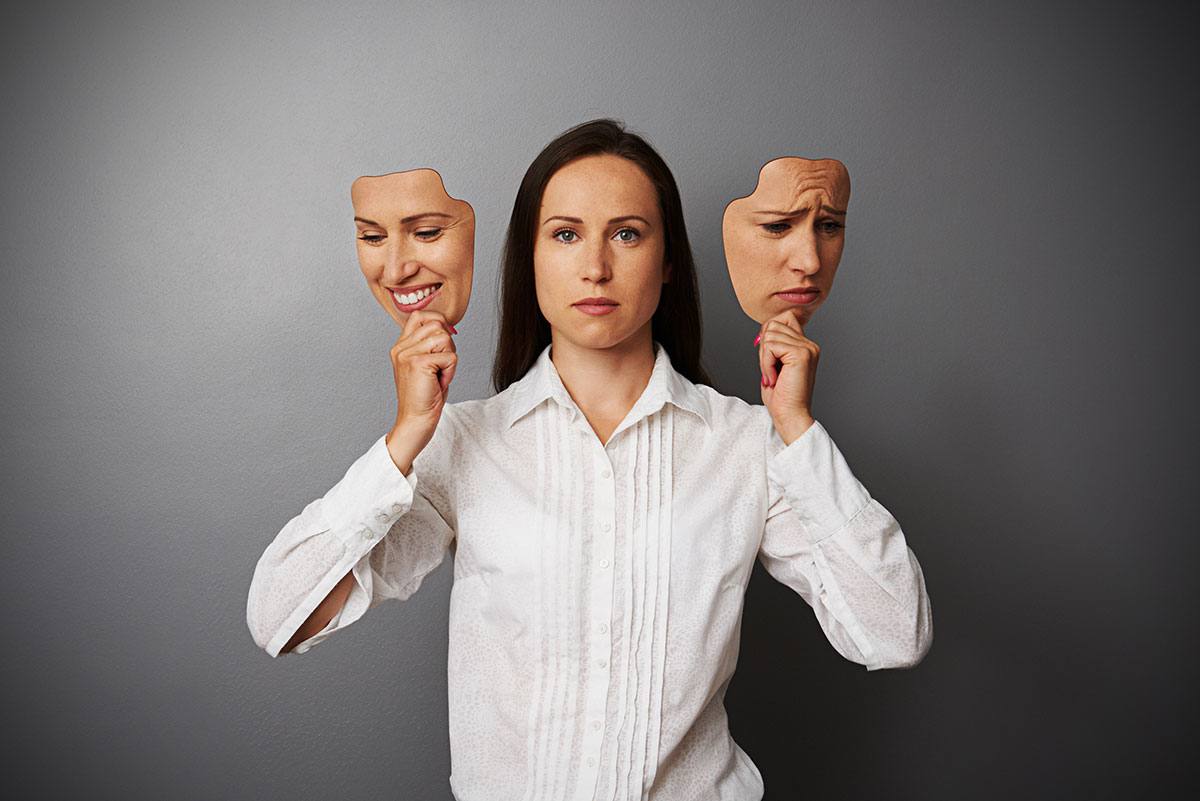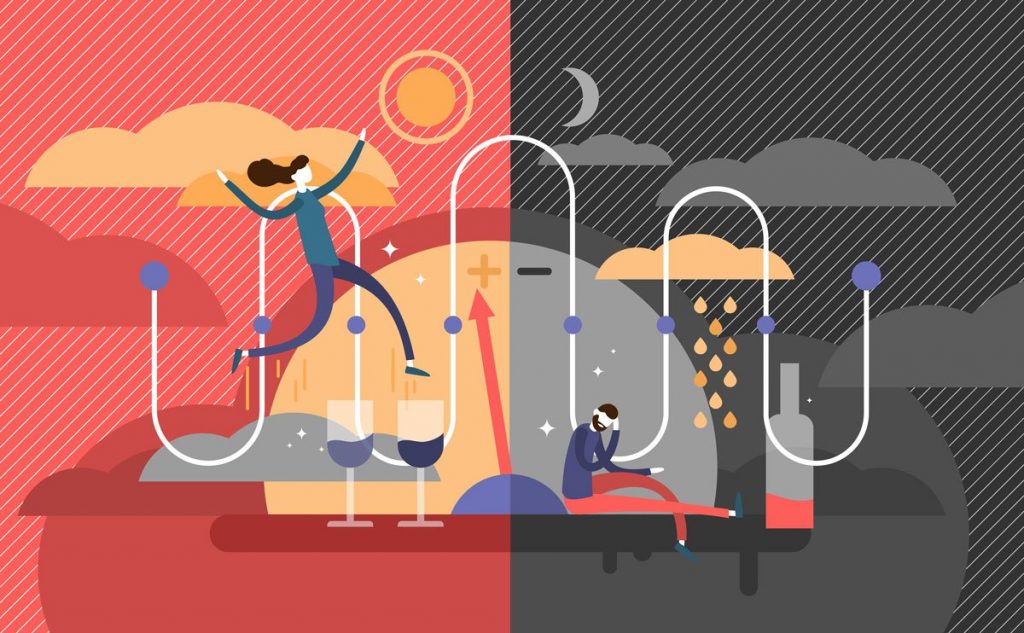Despite increased awareness of bipolar disorders, the specifics of this mental health condition are still not widely understood. Further understanding of the different manifestations of bipolar disorder can help people get the treatment they need.
It’s been gnawing at you for a while now, a persistent feeling that something is going on inside your mind that you don’t always completely understand, or even feel in control of. It might be affecting your life in ways that only you notice, such as struggling every day to keep your emotions in check so you don’t meltdown at work, or so you can get out of bed in the morning. Or it might be apparent to others, who may ask if there is anything wrong. You may be asking yourself the same thing, but unable to come to a clear answer.
You may have questions running through your mind like:
- Why can’t I really enjoy anything?
- Why is it so difficult for me to focus? I can’t remember anything and I feel so slow.
- Why am I absolutely exhausted?
- Why did I just engage in a risky, impulsive act?
- Why is my mind racing? I feel like I can barely keep up with my thoughts?
- Why am I so irritable and angry at everything?
- Why are my sleep patterns so messed up?
- Why do I go from feeling so empty and sad to feeling nearly out of control with energy?
If you are nodding your head to some of these questions, or you recognise some of these issues in a loved one, you may be seeing signs of a bipolar disorder. There are four different types of bipolar disorder, each with different symptoms and treatment needs. Understanding these types can be helpful in shedding light on what might be going on, and in pursuing the best course of treatment to successfully manage symptoms.
Common Symptoms of Bipolar Disorders: Depression and Mania
Bipolar disorders are characterised by periods of depression, mania or both. Some people living with a bipolar disorder will experience cycling through these states, moving from mania to depression or vice versa. Knowing the signs of depression and mania, which can range in their severity, can be useful in gauging whether you have had a past episode or are currently experiencing symptoms.
Signs and Symptoms of Depression
- Mood changes such as sadness, emptiness, hopelessness, and irritability
- Insomnia or oversleeping
- Lack of interest and motivation, loss of pleasure in previously enjoyed activities
- Inability to focus, make decisions, or think clearly; feeling “foggy”
- Unexplained aches and pains
- Sleeping too much or not sleeping enough
- Significant weight gains or losses
- Exhaustion, slowed speech or movements
- Thoughts of death or suicidal tendencies
Signs and Symptoms of Mania
- Increased confidence or overconfidence, euphoria
- Feeling energised to the point of losing control, “wired”
- Engaging in risky behaviours
- Rapid speech and thoughts
- Grandiose or excessive acts, such as spending sprees or exaggerated claims
- Reduced need for sleep or rest
- Increased need to be active and social
Most people with a bipolar disorder will exhibit signs in their teens and early twenties, and nearly everyone will develop it before the age of 50. People who have an immediate family member with bipolar disorder have a greater chance of developing it themselves.
Type 1: Bipolar 1 Disorder
People living with Bipolar 1 Disorder generally experience some cycling between periods of depression, and periods of mania, and have already experienced at least one manic episode in their life. Manic episodes last at least a week and have psychotic features, which means that the person will experience hallucinations, delusions or another significant disconnect from reality. This could result in hospitalisation.
Depressive episodes, which usually last around two weeks, also typically occur in Bipolar 1 Disorder. Both manic and depressive episodes can also have elements of the other – for example, you can have some symptoms of depression while experiencing mania and vice versa. In between these phases, life will feel relatively normal.
Type 2: Bipolar 2 Disorder
For those who are diagnosed with Bipolar 2 Disorder, they will not experience the mania that is a hallmark symptom of Bipolar 1 Disorder. Rather, people living with Bipolar 2 Disorder experience hypomania, which is a milder form of mania. Hypomania symptoms are similar to those of mania, and can include rapid, loud speech, racing thoughts, increased energy and a decreased need to sleep.
Instead, those with Bipolar 2 Disorder will more often experience symptoms of major depression, and cycle in and out of depressive episodes. This can sometimes lead to a misdiagnosis of depression.
Type 3: Cyclothymic Disorder
Cyclothymic disorder consists of cyclical mood swings, but of less severity than those typically found in people living with Bipolar 1 or Bipolar 2. It is not uncommon for people with Cyclothymic Disorder to be dismissed as simply “moody,” as the symptoms are not as apparent. However, research has shown that those who are living with untreated cyclothymic disorder can develop a more severe type of bipolar disorder. The symptoms of depression tend to be more significant and negatively impactful to people’s lives than symptoms of hypomania, and are generally the reason that some do seek professional treatment.
Type 4: Bipolar Disorder due to the presence of another disorder
Some bipolar disorders do not have an established pattern, and fall into a combination of the descriptions of the other three types of bipolar disorder. For example, some people will have bipolar with “mixed features,” meaning they simultaneously exhibit symptoms of depression, like hopelessness and irritability, with symptoms of mania, like restless high energy and lack of sleep. Others may experience “rapid cycling,” going through four or more episodes a year of depression or mania.
Co-occurring disorders such as anxiety, substance abuse, ADD/ADHD or eating disorders, as well as heart disease, thyroid problems, headaches and obesity, can also worsen bipolar symptoms. Some even find that seasonal change can impact their bipolar disorder.
How to Manage Bipolar Disorder
Bipolar disorder does not go away on its own, and often requires treatment with a professional mental health specialist. Skilled support helps people learn how to manage the symptoms of bipolar disorder to ensure the best outcomes for their overall health and happiness.
Psychotherapy is often an important component of treatment, and cognitive behavioural therapy can help people learn to identify and shift negative patterns of thought, while therapeutic methods focusing on stress alleviation can assuage potential triggers. A variety of options are available for treatment, and a specialist can help identify which may be most useful for each type of bipolar disorder.
Learning to Thrive at The Dawn

The Dawn Wellness Centre and Rehab in Thailand offers highly personalised, effective mental health treatment. We treat a wide variety of conditions, including the four types of bipolar disorders. Our successful “Twin Pillars” approach uses a blend of modern psychotherapies and wellness practices to heal both your mind and body, giving you all the tools you need to cope with life’s challenges.
Call The Dawn today to learn more about bipolar disorder and your treatment options.
Related Posts
 Understanding the Difference between Bipolar Disorder and Borderline Personality Disorder
Bipolar disorder and borderline personality disorder share some similarities, but at their core are two very different conditions, with different treatment needs. Knowing how to distinguish the two is the...
Understanding the Difference between Bipolar Disorder and Borderline Personality Disorder
Bipolar disorder and borderline personality disorder share some similarities, but at their core are two very different conditions, with different treatment needs. Knowing how to distinguish the two is the...
 Are You Thriving or Just Surviving? Living with High-Functioning Bipolar Disorder
Living with high-functioning bipolar disorder can mean that most of your energy is spent on handling intense internal emotions and feelings. However, trying to manage these symptoms on your own...
Are You Thriving or Just Surviving? Living with High-Functioning Bipolar Disorder
Living with high-functioning bipolar disorder can mean that most of your energy is spent on handling intense internal emotions and feelings. However, trying to manage these symptoms on your own...
 Knowing the Nuances: Understanding the Differences between ADHD and Bipolar Disorder
When you seek treatment for any mental health condition, the first step is to ensure that you have an accurate diagnosis. For ADHD and bipolar disorder, the presence of some...
Knowing the Nuances: Understanding the Differences between ADHD and Bipolar Disorder
When you seek treatment for any mental health condition, the first step is to ensure that you have an accurate diagnosis. For ADHD and bipolar disorder, the presence of some...
 Trying New Treatments: Should Adderall Be Used to Treat Bipolar Disorder?
Figuring out how to best manage bipolar disorder can be a long and challenging process. Different treatments can offer new potential for relief, but in some cases, may pose significant...
Trying New Treatments: Should Adderall Be Used to Treat Bipolar Disorder?
Figuring out how to best manage bipolar disorder can be a long and challenging process. Different treatments can offer new potential for relief, but in some cases, may pose significant...





